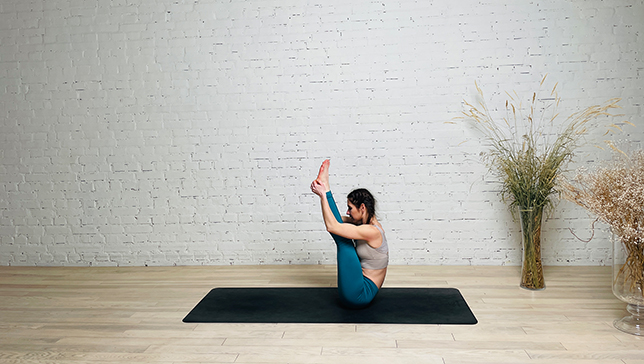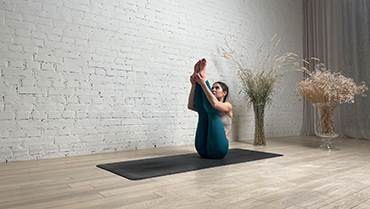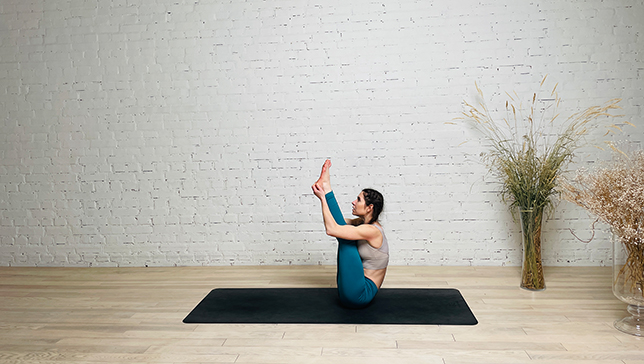Upward-Facing Intense West Stretch - Urdhva Mukha Paschimottanasana

Contents
Upward-Facing Intense West Stretch or Urdhva Mukha Paschimottanasana is a yoga pose that combines two Sanskrit words: “Urdhva Mukha” which means “upward facing,” “Paschimottanasana” which means “intense stretch of the west” or “seated forward fold.”
Urdhva Mukha Paschimottanasana is a great pose for stretching the back, shoulders, and hamstrings. It can also help to stimulate the digestive system and improve posture. It is important to practice this pose with proper alignment and to listen to your body to avoid overstretching or injury.
Pose Detail
- Difficulty: Advanced, Intermediate
- By Type: Balancing Yoga Poses, Chest Opening Yoga Poses, Flexibility Yoga Poses, Shoulder Opening Yoga Poses
- Body Position: Seated Yoga Poses
- By Benefit: Yoga Poses For Digestion, Yoga Poses For Stress Relief
Step-by-Step Instructions
Benefits and Contraindications
Stretches the back
Improves digestion
Opens the chest and shoulders
Calms the mind
Improves posture
Increases flexibility
Stimulates the abdominal organs
Pregnancy
Back or neck injury
High blood pressure
Herniated disc
Abdominal surgery
Wrist injury
Photo poses in different angles



Modifications and Props for Beginners
- Use a yoga block: If you have tight hamstrings or lower back pain, place a yoga block under your sitting bones to elevate your hips. This can help to make the pose more comfortable and less intense.
- Bend your knees: If you are not able to straighten your legs in this pose, you can bend your knees and keep your feet flat on the ground. This can help to take some of the pressure off your lower back and hamstrings.
- Use a strap: If you are not able to reach your feet with your hands, use a yoga strap to loop around your feet. This can help to lengthen your spine and stretch your hamstrings.
- Practice against a wall: If you are having difficulty lifting your chest and head off the ground, practice the pose against a wall. Start by placing your hands on the wall, then walk your feet back until your torso is parallel to the ground. Slowly lift your chest and head off the ground, keeping your hands on the wall for support.
- Use a bolster or blanket: If you have trouble with your upper back rounding, you can use a bolster or blanket to support your upper body. Place the bolster or blanket under your chest and rest your arms on the floor in front of you.
Useful Tips
- Engage your legs and core: To help support your lower back, engage your leg muscles and draw your navel towards your spine. This can help to protect your lower back and keep your spine lengthened.
- Focus on your breath: Focusing on your breath can help you to stay calm and centered in the pose.
Upward-Facing Intense West Stretch Anatomy
- Abdominal Muscles:
The abdominal muscles, including the rectus abdominis, external obliques, and internal obliques, are engaged to lift the legs off the ground and hold them in an extended position. These muscles also help to maintain stability and balance in the pose. - Hip Flexors:
The hip flexors, including the psoas major, iliacus, and rectus femoris, are responsible for lifting the legs off the ground and extending them upward. Tight hip flexors can make it difficult to maintain the pose for an extended period. - Quadriceps:
The quadriceps, including the rectus femoris, vastus lateralis, vastus medialis, and vastus intermedius, are engaged to lift the legs off the ground and extend them upward. These muscles also help to maintain stability and balance in the pose. - Glutes:
The glutes, including the gluteus maximus, medius, and minimus, are responsible for stabilizing the hips and maintaining balance in the pose. They also assist in extending the hips and lifting the legs off the ground. - Hamstrings:
The hamstrings, including the biceps femoris, semitendinosus, and semimembranosus, are lengthened in the pose to allow for greater flexibility and range of motion in the hips and legs. - Spine:
The spine is elongated in the pose to create space between the vertebrae and improve posture. The erector spinae muscles, which run along the length of the spine, are engaged to maintain the extended position. - Shoulders:
The shoulders are actively pulled away from the ears and engaged to maintain stability in the upper body. The deltoids, trapezius, and rotator cuff muscles are all involved in this movement. - Neck:
The neck is lengthened and the chin is tucked slightly to maintain alignment with the spine. The sternocleidomastoid and scalene muscles in the neck are engaged to support the head.
Frequently Asked Questions
Variations
- One-Legged Upward Facing Intense West Stretch
- Reclining Upward Facing Intense West Stretch
- Upward Facing Seated Wide Angle Pose